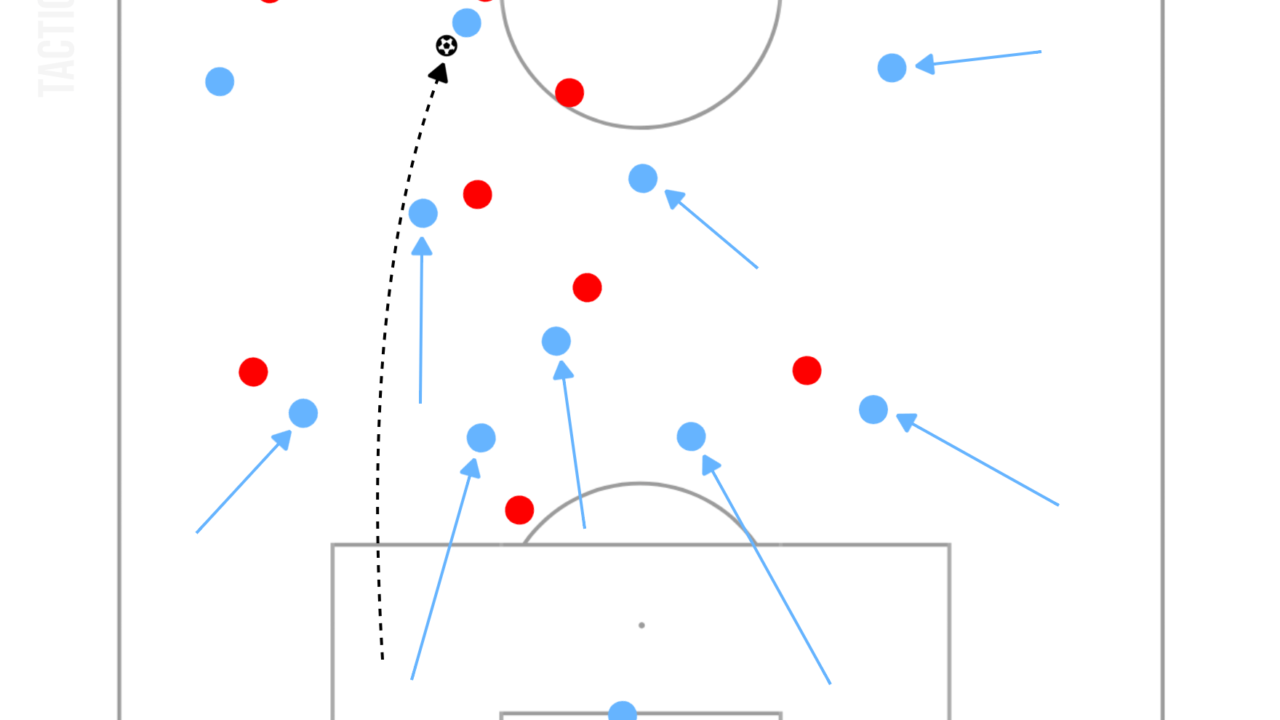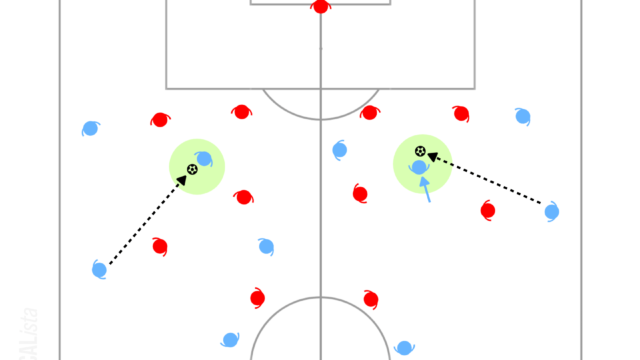How to win second balls [Football Tactical Analysis]

Introduction
The importance of securing second balls after the ball is played long is acknowledged by most coaches, but the solutions are often related to only the mentality or physicality. For example, in a team talk before the game, the phrase of ‘fight for second balls’ is shouted by a coach or captain every time. I never ignore these aspects of football, but I think tactics, or the positions and movements of players should be also considered. Therefore, what kind of positions or movements are beneficial to win second balls is going to be discussed in this article.
The second ball situation, or transitional moment is more unpredictable than building up or even final third attacking, so the anticipation or reaction, which is related to the mentality, has been emphasised more. However, tactics can increase the chance of winning the second ball, although it cannot guarantee it.
Due to the randomness of the point where the ball drops, it is difficult to predict exactly where to position themselves. Instead, creating an overload around the area where the ball is played and the aerial duel occurs basically increases the chance of securing the second ball. To achieve this, keeping the compactness of the shape can help to create an overload. The compactness is more important than just an overload. This is because the ball can be headed forwards, backwards or horizontally depending on the result of the aerial duels. Therefore, maintaining the compactness to be ready for the various angles is more important than just having an overload in a certain area.
Then, what kinds of second ball situations are crucial in a game? The long goal kicks after both teams being positioned in the midfield of the pitch are tactically less important because both teams are doing their best tactically so let’s trust to luck or believe in the speed of reaction or the mentality.
The situation where tactics are more important is when the ball is played long in open shapes. For example, the shapes of both teams are stretched when the defending team tried to press high against the attacking team which initially played short from the back. In this case, how to shift to the compact shape quicker than the opposition team is important to create an overload around the ball to secure the second ball. They need to move smoothly, so the tactical help is required. From the following chapters, tactics to win the second balls from both attacking and defensive perspectives are going to be discussed in detail.
From an Attacking Shape to a Defensive Shape
In possession, it is commonly recommended for players to spread across the pitch and keep the width to make it big. The main reason is trying to force the opposition defenders to stretch to create a gap to play through. To make the pitch big is important when playing out from the back, but it turns into the weakness when the ball is played long due to the opposition pressure.

As the attacking shape is more stretched than the opposition defensive shape, the opposition team is likely to have an overload around the ball. If the problem is just losing the ball, it will not be a huge weakness. However, as soon as the opposition team regains the second ball, they can easily play through even the back line.
To avoid this, it is obviously important to shift to the compact shape as soon as the ball is played long, and coaches often shout ‘push up!’ to the defenders to achieve that. However, what actually they need to do is not moving just forwards. Look at the illustration above. As they are positioned in various areas on the pitch, if they just step up forwards, the distances between them is too long and there are also gaps to be exploited. Therefore, what they are required to do is shuffling towards the ball side with turning especially the back line into the defensive version.

Not only stepping up forwards to make the space in between the lines compact, but also narrowing the distance between each other on the same lines is crucial. This can help the team to create an overload around the ball and also be ready for managing the opposition counterattacks even if the second ball is secured by the opposition player.
Therefore, movements of players are diagonal and they are all different. So, I do not know how much it affects, but I suggest saying ‘compact’ rather than ‘push up’ because telling players the objective is more effective than dictating the action. And obviously ‘push up’ is not enough…
From Man Marking to Zonal Defending
When discussing the pressing tactics, I often hear the conversation ending with ‘…, then we can create a man marking situation here to win the ball or force them to play long’. How to secure the second balls after allowing the opposition team to play long? If there is a tall or strong opposition player up front such as Inter Milan, managing the second balls is extremely important. Then, in this chapter, how to manage the balance between man marking and zonal defending to secure the second balls is going to be discussed.
When pressing high even towards the goalkeeper or centre backs in the box, it is difficult to keep applying pressure on the ball with maintaining the compactness of the shape. Therefore, the defending team tries to create man marking situation around the ball, but the question is how many players are included in the area around the ball.
If two players of the defending team marks two opposition team in possession around the ball, the player on the ball will easily find a third player to play away from the pressure. On the other hand, if the players of the team out of possession marks five or six players around the ball, the player on the ball needs to find a sixth or seventh teammate, but it is usually difficult. However, thanks to the players of the defending team stepping up to find each player to mark, the space between the lines where the second ball can drop after the ball is played long is likely to be huge.

As it was mentioned earlier, the key to win the second balls is creating an overload and maintaining the compactness of the shape, so the situation illustrated above is not favourable for both teams, which means it is almost a 50/50 situation. In other words, if a team can shift to the shape for the second ball quicker than the opposition, they can take an advantage. For the attacking team, it was mainly about how the defenders step up diagonally to close the gap between the lines and defenders. On the other hand, the defending team can prepare for the transitional situation before the ball is played.
As it was mentioned, the balance of players who mark the opposition players around the ball is important. Three or four players around the ball should be marked tightly to apply pressure on and around the ball, but the more importantly the opposite side players need to prepare for the situation after the ball is played long.

The back line needs to be ready for the ball flicked by the opposition striker and the opposite side players are required to tuck in to create a compact shape. The most important player is the opposite side midfielders. If it is a pair of double pivots, it is going to be either of them and if it is a midfield three, it is going to be the central midfield and the opposite side midfielder. They need to protect the space between the players who mark the opposition players around the ball and defenders.
The best example is Manchester City who are excellent at pressing. Their recoveries in the opposition half were thanks to the effort of Rodrigo and İlkay Gündoğan. When they press high, the system is often a 4-4-2 and they play as the defensive midfielders. They can play as a pair, in other words, if one of them steps up to press, the other drops back to cover the space between the lines. Therefore, when the ball is played long and drops in between the lines, one of them is ready for securing it. This is the reason why City could win the ball high and keep playing in the opposition half.
The balance is important, but there is no border of how many players should mark the opposition players around the ball because it depends on the systems or the way of positioning. Therefore, another key is anticipating how the ball will be played and react quicker than the opposition player, who the player is marking, as soon as the ball is played long. If the ball is not likely to be played short, there is no point to step up to mark the opposition player with leaving the space behind. Thus, it is required to anticipate it. Additionally, this can be applied to both teams though, it is important to react quickly and do what they need to do, which were mentioned in this article so far.
Conclusion
The main thing to increase the chance of winning the second ball is creating an overload and a compact shape. This cannot guarantee it, but thanks to the compact shape, it is possible to prevent the opposition team from playing counterattacks and exploiting gaps. The situation of second balls is not as systematic or logical as build up or pressing, but it is also a fact that there is something tactics can do. Thanks for reading. I hope you enjoyed it.


